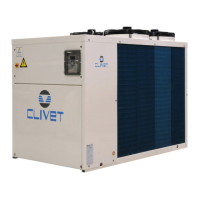24
Check that the air and water temperatures are included in the
working limits
For information on the control system, refer to the paragraph
CONTROL.
Start the unit
With unit of full load, namely in stable conditions and close to
those of work, check :
Power supply tension
Total absorption of the unit
Absorption of the single electric loads
6.6 TENSIONS
6.8 STARTING REPORT
Realize the operating objective conditions is useful for check
the unit over time.
With unit of full load, namely in stable conditions and close to
those of work, take the following data:
Tension and general absorptions with unit at full load
Absorption of varied electrical loads (compressors, fans,
pumps etc)
Temperatures and capacities of different liquid (water, air)
in the inlet and outlet of the unit
Temperatures and pressures on the refrigerant circuit
characteristic points (compressor discharge, liquid, intake)
The remarks should be preserved and available during
maintenance .
97/23 CE PED DIRECTIVE gives instructions for installers,
users and maintenance technicians as well.
Refer to local actuation norms; briefly and as an example, see
the following
Compulsory verification of the first installation :
only for units assembled on the installer’s building site
(for ex. Condensing circuit + direct expansion unit)
Certification of setting in service :
for all the units
Periodical verifications:
to be executed with the frequency indicated by the
manufacturer (see the maintenance section)
6.9 CE 97/23 PED DIRECTIVE
Check that the remote commands (ON-OFF, etc.) are
connected and if necessary enabled with the relevant
parameters as described in ELECTRICAL
CONNECTIONS section
Check that probes or optional components are connect
and enable with the relative parameters( ELECTRICAL
CONNECTION section)
6.7 REMOTE CONSENT
6 - START-UP
SUMMER
With outside low temperatures the refrigerant requirements
are reduced.
The internal comfort can also be obtained with a set-point
higher than standard.
The correction is summed to SP set-point :
it increases at the outside temperature T.Ex. decreasing
WINTER
With outside mild temperatures the thermal requirements are
reduced.
The internal comfort can also be obtained with a lower se-
tpoint.
The correction is subtracted to SP set-point :
it decreasing at the outside temperature T Ex. increasing
Configuration parameters
4 CompExt
External temp. comp. enabling
0=No, 1=Cool, 2=Heat, 3=Always
112 CextMaxC Ext. Temp. max. winter correction
113 CextMinC Ext. Temp. min. winter correction
114 CextMaxH Winter correction max. value
115 CextMinH Winter correction min. value
116 MaxCExtC Summer correction max. value
117 MaxCExtH Winter correction max. value
118 HExtMinC Ext. enthalpy min. correction
119 HExtMaxC Ext. enthalpy max. correction
6.10 SETPOINT CORRECTION FOR OUTSIDE
TEMPERATURE

